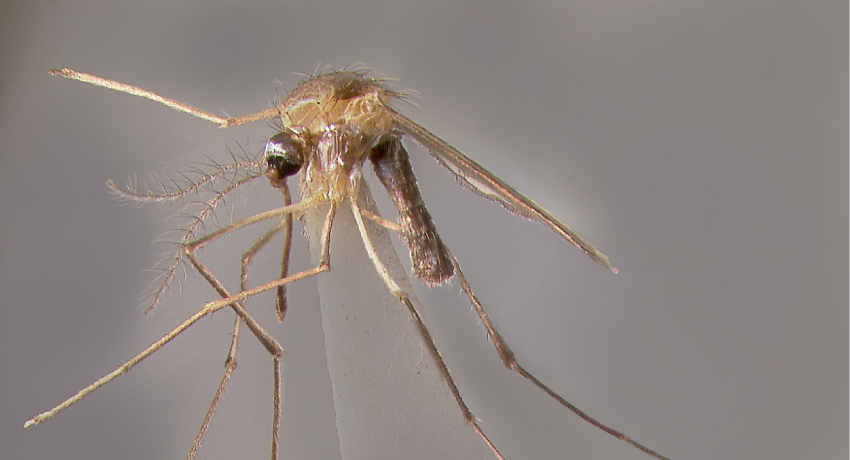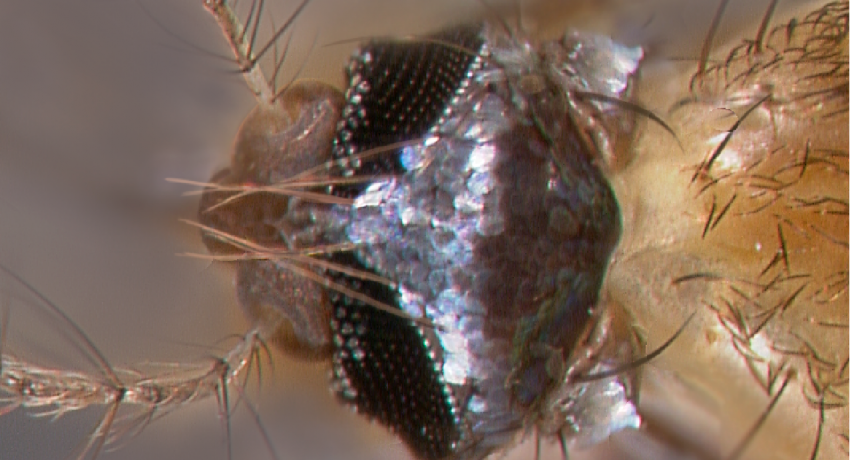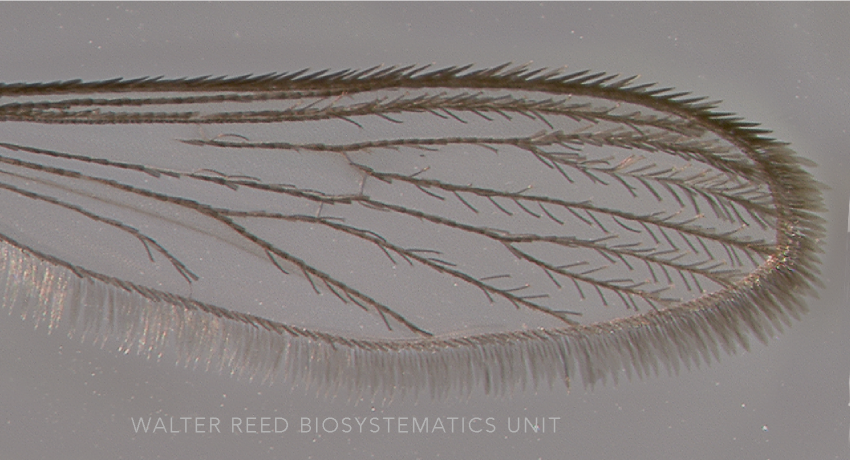AFROTROPICAL, AUSTRALASIAN & ORIENTAL REGIONS
Generic abbreviation: Ho.
Type species: Hodgesia sanguinae Theobald
Etymology: Aubrey Hodges
Hodgesia mosquitoes are incredibly tiny and are often overlooked in light trap collections, or escape through larger meshes. They are identified by the unique, elongate, fork-tipped scales on the distal half of their wings. The eleven described species in genus Hodgesia species include Ho. bailyi Barraud, Ho. cairnsensis Taylor, Ho. cyptopus Theobald, Ho. lampangensis Thurman, Ho. malayi Leicester, Ho. nigeriae Edwards, Ho. psectropus Edwards, Ho. quasisanguinae Leicester, Ho. sanguinae Theobald, Ho. solomonis Belkin and Ho. spoliata Edwards.
The jungle-associated genus Hodgesia is the only genus in the tribe Hodgesiini, and is often regarded as sister to the genus Ficalbia of the tribe Ficalbiini. The fusion of the larval cardo and maxillary palps, and the complete hypostomal suture distinguish Hodgesia species from Ficalbia species. Hodgesia larva exhibit an unusual basal placement of seta 1-S on the siphon—a character only otherwise shared only by species of the genus Culiseta (tribe Culisetini).
DIAGNOSTIC CHARACTERS (Click photos to view; mouse over and click large photo to zoom in.)
ADULT (illustrated): Head: Head scales flat and broad, silvery scale patch toward vertex; scutum usually without markings, except broad silvery scales on the antepronotum. Thorax: Pleuron with a patch of silvery scales and much-reduced setae; acrostichal setae absent, dorsocentral setae prominent. Wing: Vein 1A terminates level with base of mediocubital crossvein; wing membrane with distinct microtrichia; scales on distal half long and notched at tips.
LARVA (not illustrated): Head: Seta 1-A large, inserted near apex of antenna. Terminal segments: Siphon short, with seta 1-S attached at base; pecten well developed; saddle complete.
TAXONOMIC KEYS
Edwards 1941 (Afrotropics)
Hopkins 1952 (Afrotropics)
Lee et al. 1988 (Australasia)
Service 1990 (review; Afrotropics)
Rattanarithikul & Harrison et al. 2005 (Thailand)
Rattanarithikul et al. 2010 (Thailand)
![]()
WRBU – Genera – Global – Larva
![]()
WRBU – Genera – Afrotropical – Adult
![]()
WRBU – Genera – Afrotropical – Larva
![]()
WRBU – Genera – Australasia – Adult
![]()
WRBU – Genera – Australasia – Larva
![]()
WRBU – Genera – IndoMalaya – Adult
![]()
WRBU – Genera – IndoMalaya – Larva
![]()
WRBU – Genera – Oriental – Adult
![]()
WRBU – Genera – Oriental – Larva
Exemplar DNA sequences
Ho. bailyi COI: EU259292
BIONOMICS
Immatures
Immature Hodgesia are found in permanent freshwater jungle ground pools and swamps, teaming with dense vegetation, often in sympatry with Mimomyia species.
Adults
Hodgesia solomonis viciously attacks people in jungle areas of the Solomon Islands. Several species, including the Afrotropical Ho. sanguinae, and the Oriental Ho. malayi and Ho. quasisanguinea, have been collected biting people during the day near their larval habitats.
*Associated pathogens: This list reports bacteria, viruses, and parasites recovered from, or experimentally passed through this species, and does not imply field vector status.
IMPORTANT REFERENCES (full citations below)
Theobald 1904a: 17 (as genus)
Harbach & Kitching 1998 (phylogeny)
Barraud 1934 (taxonomy, south Asia)
Edwards 1941 (M, F, P; keys, taxonomy, bionomics; Afrotropics)
Hopkins 1952 (L; key, taxonomy, bionomics; Afrotropics)
Lee et al. 1988 (F; key, taxonomy, bionomics, distribution; Australasia)
Service 1990 (review; Afrotropics)
Rattanarithikul & Harrison et al. 2005 (F, L; tax. keys, bionomics; Thailand)
Rattanarithikul et al. 2010 (F*, L*; keys, bionomics, distribution; Thailand)
VALID SUBGENERA
None
CURRENT GENERIC SYNONYMS
None
CITED REFERENCES
Barraud, P. J. (1934). The fauna of British India, including Ceylon and Burma. Diptera. Vol. 5. Family Culicidae, tribes Megarhinini and Culicini (Vol. 5). London: Taylor and Francis.
Edwards, F.W. (1941). Mosquitoes of the Ethiopian Region. III. Culicine adults and pupae. Bulletin of the British Museum (Natural History) Entomology.
Harbach, R.E. & Kitching, I.J. (1998). Phylogeny and classification of the Culicidae (Diptera). Systematic Entomology, 23(4), 327–370.
Hopkins, G.H.E. (1952). Mosquitoes of the Ethiopian region. I. Larval bionomics of mosquitoes and taxonomy of culicine larvae (2nd ed.). London, UK: British Museum (Natural History).
Lee, D.J., Hicks, M.M., Debenham, M.L., Griffiths, M., Bryan, J.H., & Marks, E.N. (1988b). The Culicidae of the Australasian region. Volume 9. Commonwealth Department of Health, School of Public Health and Tropical Medicine Monograph Series, 2.
Rattanarithikul, R., Harbach, R.E., Harrison, B.A., Panthusiri, P., Coleman, R.E., & Richardson, J.H. (2010). Illustrated keys to the mosquitoes of Thailand VI. Tribe Aedini. Southeast Asian Journal of Tropical Medicine and Public Health, 41(1), 1–225.
Rattanarithikul, R., Harrison, B.A., Panthusiri, P., & Coleman, R.E. (2005). Illustrated keys to the mosquitoes of Thailand. I. Background; geographic distribution; lists of genera, subgenera, and species; and a key to the genera. Southeast Asian Journal of Tropical Medicine and Public Health, 36(1), 1–80.
Service, M.W. (1990). Handbook to the Afrotropical toxorhynchitine and culicine mosquitoes, excepting Aedes and Culex. British Museum (Natural History).
Theobald, F.V. (1904a). A new culicid genus from Uganda. Journal of Tropical Medicine, 7, 17–18.
CITE THIS PAGE
Walter Reed Biosystematics Unit (Year). Hodgesia genus page. Walter Reed Biosystematics Unit Website, http://wrbu.si.edu/vectorspecies/genera/hodgesia, accessed on [date (e.g. 03 February 2020) when you last viewed the site].





